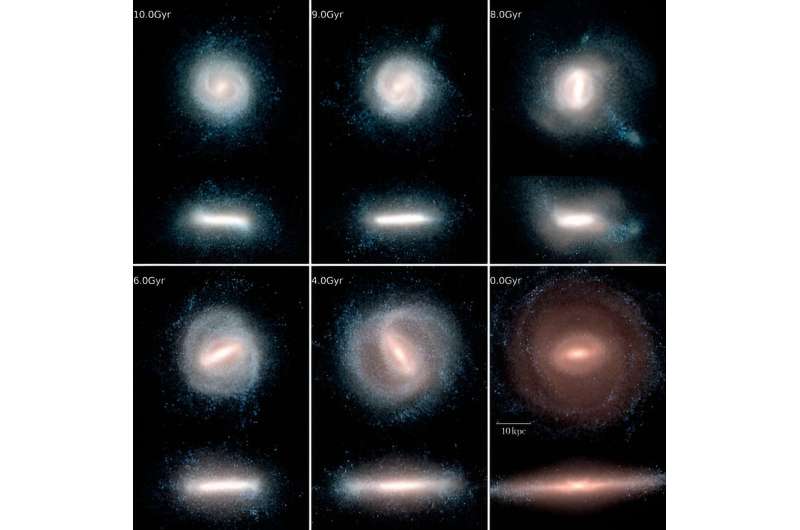This article has been reviewed according to Science X's editorial process and policies. Editors have highlighted the following attributes while ensuring the content's credibility:
fact-checked
preprint
trusted source
proofread
Did the last great galactic merger create the Milky Way's bar?

The Milky Way is a spiral galaxy. More specifically, it is a barred spiral galaxy, meaning that within its central region, there is a bar shape off of which the spirals emanate. About two-thirds of spiral galaxies are barred spirals, and astronomers have thought this difference is just a variance in how density waves cluster stars in a galaxy. But a new study suggests that the bar of the Milky Way may have been caused by an ancient collision with another galaxy.
Although it is our home, the Milky Way is in some ways the least understood galaxy. It's difficult for us to map its structure in detail. Fortunately, large sky surveys such as the one by the Gaia spacecraft are finally giving us a detailed view. One of the things Gaia has shown is that several galaxies have collided with the Milky Way in the past.
One of the largest collisions is known as the Gaia Sausage. It is the remains of a dwarf galaxy that struck the Milky Way about 8 to 11 billion years ago. As a result of this collision, our galaxy gained about 50 billion solar masses, and at least eight globular clusters. Gaia observations show the remnants of this collision in the velocity distribution of stars in our galaxy.
Interestingly, 8 to 11 billion years ago was around the same time that the Milky Way developed its barred spiral structure. So the team wanted to find out if there was a connection. Using computer simulations, they looked at how galactic collisions could result in a barred galaxy.
Earlier studies have shown that galactic collisions can often create a barred structure, so simply showing a collision could have formed via a collision isn't a strong argument that it did. So the team focused on the particular timing of how the bar formed. Based on their simulations, the team found that without the Gaia Sausage collision, there could be a 2-billion-year delay in the formation of a bar. The paper is published on the arXiv preprint server.
The conditions of the early Milky Way would in some ways act to delay bar formation. With the Gaia Sausage collision, a bar formed much earlier in the simulations. So while the study doesn't prove the Milky Way's bar was directly caused by the Gaia Sausage collision, it does show that evidence for an old bar structure strongly implies that its formation was triggered by the collision.
As more sky surveys come online, and we continue to make a detailed map of our galaxy, we will better understand the dynamics of our galactic structure. For now, however, it seems that barring a collision the Milky Way may have remained a simple spiral galaxy for billions of years.
More information: Alex Merrow et al, Did the Gaia Enceladus/Sausage merger form the Milky Way's bar?, arXiv (2023). DOI: 10.48550/arxiv.2312.02318
Journal information: arXiv
Provided by Universe Today





















